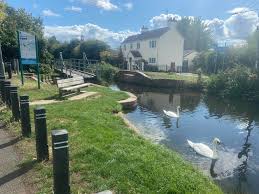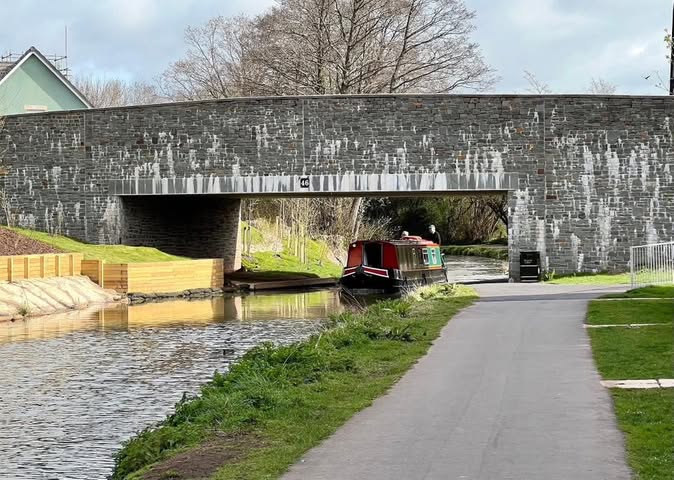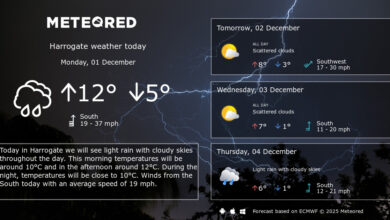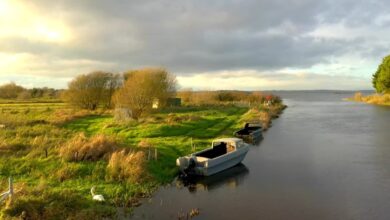
Tucked away in the heart of South Wales lies a hidden treasure for walkers, history lovers, and nature enthusiasts—the scenic route from Bridge 46 to Five Locks. This stretch of the Monmouthshire & Brecon Canal offers a perfect blend of industrial heritage and tranquil landscapes. Whether you’re interested in learning about the role canals once played in South Wales’ booming coal industry, or you’re simply looking for a peaceful towpath stroll, this route provides a unique glimpse into both the past and present.
The Monmouthshire & Brecon Canal is one of Wales’ most beloved waterways, celebrated for its picturesque scenery and rich historical background. Running for over 30 miles, it winds its way through villages, countryside, and historic engineering features. The section from Bridge 46 to the impressive Five Locks flight is especially significant, offering visitors an opportunity to experience canal life at its best.
What makes this walk so appealing is its versatility. Families, casual walkers, and seasoned ramblers all find enjoyment here. With calm waters reflecting the surrounding greenery, charming stone bridges, and the fascinating sight of the lock system, this canal walk is much more than just a route—it is an immersive journey. In the following sections, we’ll explore the history, the highlights, and practical visitor information you need to make the most of your trip along Bridge 46 to Five Locks.
The History of Bridge 46 to Five Locks
To truly appreciate the Bridge 46 to Five Locks walk, it helps to understand its origins. The Monmouthshire & Brecon Canal dates back to the late 18th century and played an essential role in South Wales’ industrial boom. At a time when coal and iron dominated the region’s economy, canals provided an efficient way of transporting heavy goods to docks and markets. Before railways took over, these waterways were the arteries of Welsh industry.
The stretch between Bridge 46 and Five Locks showcases some of the most interesting engineering features of the canal. The Five Locks flight, in particular, is an impressive staircase of locks that allowed boats to navigate steep changes in water levels. For the boatmen of the past, maneuvering through these locks was both a challenge and a daily routine. Today, the locks remain a symbol of industrial ingenuity, admired by visitors who walk alongside them.
Over the years, the canal faced decline as railways became the preferred mode of transport. By the mid-20th century, parts of the canal had fallen into disrepair. However, thanks to restoration efforts, sections such as Bridge 46 to Five Locks have been preserved for leisure, tourism, and education. Walking this route today feels like stepping back in time while also appreciating the efforts to keep this heritage alive. The legacy of trade, engineering, and community life is etched into every stone bridge and water gate along the way.
Walking the Route from Bridge 46 to Five Locks

Embarking on a walk along Bridge 46 to Five Locks offers more than just physical exercise; it provides a chance to connect with nature and history simultaneously.
Starting at Bridge 46
Bridge 46 is a charming entry point, surrounded by peaceful countryside and easy to reach from nearby towns. As you step onto the towpath, the sound of water lapping against the canal edges sets a soothing tone. Many visitors start their journey here to enjoy a leisurely walk toward the more dramatic features ahead.
Along the Towpath
The towpath is well-maintained, making it suitable for a wide range of visitors. Strolling along, you’ll encounter lush greenery, wildflowers, and perhaps spot a heron poised by the water’s edge. Families enjoy this section for its calm, safe environment, while photographers are often drawn to the reflections of arched bridges mirrored in the canal. The serenity of the route makes it feel far removed from the bustle of modern life.
Reaching Five Locks
As you approach the Five Locks flight, the scenery becomes even more captivating. Here, five consecutive locks step down the landscape, creating an impressive view of canal engineering. The lock system is both functional and beautiful, offering insight into the challenges faced by boatmen centuries ago. For visitors today, Five Locks is a highlight—an awe-inspiring reminder of human innovation set within the natural beauty of South Wales.
Attractions and Points of Interest Nearby
Beyond the towpath itself, the Bridge 46 to Five Locks walk is dotted with attractions that add to the experience.
One of the main highlights is the Five Locks Basin, once a busy hub for canal trade. Today, it has been revitalized as a heritage site where visitors can learn about the history of canals, locks, and the communities that relied on them. Information boards and restored structures bring the past to life, making it an educational stop for families and school groups.
Along the route, you’ll also come across historical remnants such as stone bridges, aqueducts, and cottages once inhabited by lock keepers. Each feature tells its own story about life on the canal and the importance of waterways in shaping South Wales. Local legends and folklore add extra layers of interest, ensuring that every step offers something new to discover.
For those seeking refreshments, the nearby town of Cwmbran offers cafés, pubs, and shops where you can rest after your walk. Many visitors also enjoy bringing a picnic to enjoy by the canal, especially during warmer months. Seasonal highlights, such as autumn walks with vibrant foliage or springtime blooms along the water’s edge, make this route attractive year-round. For photographers and nature lovers, the ever-changing scenery provides endless inspiration.
Practical Guide for Visitors
Planning your trip to Bridge 46 to Five Locks is straightforward, but a few tips will ensure you get the most from your visit.
Getting There
Bridge 46 and the Five Locks flight are accessible from nearby towns like Cwmbran and Pontnewydd. For those traveling by car, parking is available near both ends of the route. Public transport options include buses and trains, making it easy to reach even if you’re coming from further afield.
Walking & Cycling Information
The walk itself is manageable for most fitness levels. It’s relatively flat and suitable for families with prams or visitors with mobility considerations, though some uneven areas may require care. Cyclists are welcome along the towpath, but it’s important to share the space responsibly with walkers.
Tips for a Great Visit
The best time to walk the route is during spring or autumn, when the weather is pleasant, and the scenery is at its most colorful. Summer offers long, bright days, but it can be busier with tourists. Winter walks, while colder, provide a peaceful atmosphere and frost-tipped beauty. Essentials to bring include sturdy shoes, water, and a camera to capture the sights. Safety is simple—keep children close to the towpath edge and take care around locks where water levels change.
Conclusion
The Bridge 46 to Five Locks walk is a remarkable blend of history, engineering, and natural beauty. It stands as a testament to South Wales’ industrial past while providing a peaceful retreat for modern-day visitors. From the charming entry point at Bridge 46 to the dramatic lock staircase, every step offers insight and enjoyment.
For locals, it is a reminder of their heritage; for visitors, it is an unforgettable experience of Welsh culture and landscapes. Whether you’re a casual stroller, a history enthusiast, or a nature lover, this route offers something meaningful. Exploring this stretch of the Monmouthshire & Brecon Canal is more than just a walk—it’s a journey into the soul of South Wales.
FAQs about Bridge 46 to Five Locks
Where exactly is Bridge 46 on the Monmouthshire & Brecon Canal?
It is located near Cwmbran in South Wales, providing access to the towpath leading to Five Locks.
How long does it take to walk from Bridge 46 to Five Locks?
The walk typically takes around 45–60 minutes, depending on pace and stops.
Is the route family-friendly?
Yes, the towpath is safe and suitable for families, including those with prams.
Can you cycle along this stretch of the canal?
Yes, cycling is allowed, but cyclists should give way to walkers.
Is there parking available near Five Locks?
Yes, car parks are located near both Bridge 46 and the Five Locks Basin.
Are there pubs or cafés along the route?
Nearby towns such as Cwmbran offer dining options close to the canal.
What wildlife can be seen on the walk?
Common sightings include swans, ducks, herons, and seasonal wildflowers.
When was the Five Locks flight built?
The lock system dates back to the late 18th century as part of the canal’s industrial expansion.
Are guided tours available in this area?
Yes, some heritage groups and local guides offer canal tours and educational walks.
What makes this canal walk unique compared to others in Wales?
Its combination of industrial history, stunning engineering, and peaceful nature makes it stand out as one of South Wales’ most captivating walks
You May Also Read: Largs Market




